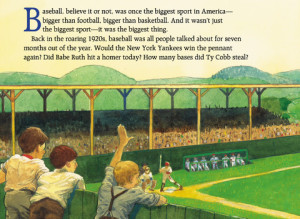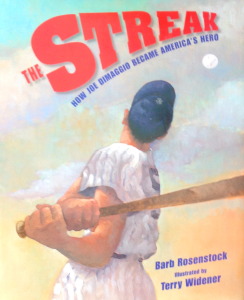 Jonah Winter’s first picture book biography came out around 20 years ago. He has done another fine book in Joltin’ Joe DiMaggio illustrated by the great James E. Ransome. Winter breaks the “rule” of staying under 1000 words (I quickly counted between 1300-1500, plus an author’s note.) Why? To tell a thorough life story of Joe DiMaggio (including the Marilyn Monroe era!) and, well, yeah…he is Jonah Winter.
Jonah Winter’s first picture book biography came out around 20 years ago. He has done another fine book in Joltin’ Joe DiMaggio illustrated by the great James E. Ransome. Winter breaks the “rule” of staying under 1000 words (I quickly counted between 1300-1500, plus an author’s note.) Why? To tell a thorough life story of Joe DiMaggio (including the Marilyn Monroe era!) and, well, yeah…he is Jonah Winter.
All picture book “rules” can be broken… BUT, not before you know what they are and WHY they exist. In terms of nonfiction, historical fiction and biography, here’s my simple take on the “rule” of length. It’s there to remind you not to bore the pants off your readers.
Us research-loving types tend to want to throw every little (and big) thing we learn about our subjects/story into our manuscripts. In writing picture books though, a constant stream of information can bog down a story arc, while a tangent, no matter how fascinating, can break it all together. Is it hard to leave out the facts you fall in love with as you are researching and writing? Yes. (oh yes, it is soooo hard!)
Most inf ormation is best kept in your file folders, not in your manuscript. If I had to guess, my own information ratio is 80:20. 80% of what I know about the subject stays out, but the 20% that goes in is super specific to THIS story. In other words, you’re looking to include tight details rather than the broad birth-to-death information found on Wikipedia.
ormation is best kept in your file folders, not in your manuscript. If I had to guess, my own information ratio is 80:20. 80% of what I know about the subject stays out, but the 20% that goes in is super specific to THIS story. In other words, you’re looking to include tight details rather than the broad birth-to-death information found on Wikipedia.
I’ve written first drafts of picture books as long as 2000 words. While it is a happy day when a draft is done and the story has a shape, it is almost always mixed with pain after a glance at Tools – Word Count. For me, there is a minute (or more honestly, three or four days…) when I think, “Half the words? I give up! It can’t be done!”
Yet, it (almost) always does get done. How? By repeatedly asking: How does this page, paragraph, sentence or word contribute to telling this story? Only words that move the story along are invited to stay, the rest are cut. It’s an exclusive guest list. If you can throw a complete party with 250 words, great, if it’s 700, fine, but if it is 1400 words, your reasons for inviting that many should be airtight. Once an editor (the person paying for your party) reads your manuscript, you will be justifying each one.
 If you’re interested, check out Winter & Ransome’s Joltin’ Joe DiMaggio and my own book The Streak: How Joe DiMaggio Became America’s Hero, illustrated by Terry Widener, to read two styles of biography published in the same year on the same subject. And learn to be ruthless with your guest list—invite the number of words you need, and not one more.
If you’re interested, check out Winter & Ransome’s Joltin’ Joe DiMaggio and my own book The Streak: How Joe DiMaggio Became America’s Hero, illustrated by Terry Widener, to read two styles of biography published in the same year on the same subject. And learn to be ruthless with your guest list—invite the number of words you need, and not one more.

Thank you for the blogpost. I find that sometimes there’s so much great research, it’s hard to know where to start the biography. To me, it is a relief once the first draft is done and I can start revisions. I have enjoyed the books of yours I’ve read and look forward to reading this one.
Thanks Patricia, yep sometimes the hardest thing is to stop researching and just get the story out!
I love picture book biographies, and am always curious about how the author chose what to include — it can’t be easy! I look forward to reading both yours and Jonah’s. Thanks, Barb!
Not everyone works the same, but for me I try to only include what moves the story along and makes me say “I didn’t know that” when I was researching. Thanks for reading!
Such great, GREAT advice – and not just for bios! Thanks so VERY much.
And advice I need to remind myself of once a week (at least) thanks for reading!
GREAT advice, Barb. I’m studying picture book biographies right now, too, so I was happy to add these to my must-read list.
🙂
And by the way, yesterday I got my first look at your Thomas Jefferson Builds a Library at our Iowa SCBWI conference. When I finished, I hugged it to me and sighed. Does that tell you how I felt about it? 🙂
Awww, thanks.
Excellent post on cutting words! I wrote my first pb biography draft last spring, and it was very painful to cut out sooo many of the words of my first draft. But the story is all the more stronger because of it!
Not just cutting words, but many times cutting entire scenes, skipping time, characters, etc. You’re right, a picture book story is almost always stronger for it!
I love a small intimate party over a big bash any day! Regional SCBWI conference = whee! SCBWI NYC or LA = no way! So this post really resonated for me to keep my guest list small at the NF PB bio party. 🙂